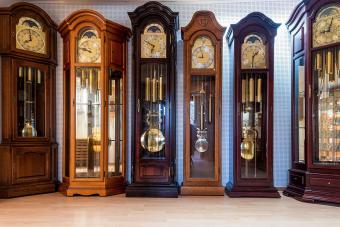
If you grew up visiting your grandparents' house, you're probably intimately familiar with the iconic bing-bongs that their old grandfather clocks made every hour on the hour. Once a staple piece of decoration in the home, many group all tall clocks, whether they're grandfather or grandmother clocks, into the same category. However, there're a few major differences between grandfather and grandmother clocks to know, as they might not affect their sentimental value but can impact how much they're worth.
Difference Between Grandfather and Grandmother Clocks
Honestly, you're not alone if you've incorrectly labeled a grandmother clock as a grandfather clock. When it comes to the differences between these two types of upright clocks, they appear quite similar. To an unknowing eye, these clocks look practically the same. Despite grandfather and grandmother clocks' incredible visual similarities, there are a few concrete differences between the two that're important to know if you're thinking about selling or insuring either.
Sizes

Longcase clocks, which include both grandfather and grandmother clocks, are characterized by their long, swinging pendulums which--with every swing--keep time. Functionally, grandfather and grandmother clocks are exactly the same. Both of their mechanisms operate to keep time in the same fashion. Thus, the main difference in these clocks actually comes down to their size. According to ClockCorner, a clock repair service and timepiece retailer, grandfather clocks are at a minimum 6 feet tall (though they reach heights of 9-10 feet), and grandmother clocks come in at a shorter status of 5-6 feet high.
Manufacturing Dates

Leon Neal / Staff / Getty Images News / Getty Editorial Use Getty Images License - Getty Editorial Use The face of a Gravell and Tolkien grandfather clock | Getty Editorial Use
While grandfather clocks have been in production for a few hundred years, they began taking hold as a popular item to have around the house in the 19th century. Victorians and Reconstruction Era people sure did love their tall cases. In contrast, grandmother clocks weren't really manufactured until the 20th century's interwar years (1930s-1940s) as mass manufacturing costs lowered the price to make large clocks, and more people wanted these clocks in their smaller-sized homes.
Famous Grandmother and Grandfather Clock Makers

Once you've taken out your tape measure to pin down your tall clock's size, you might want to find out more information about where your clock came from and just how old it is. A good place to start is determining who made your clock. Many manufacturers have their marks inscribed or printed on the clock's face (dial), but if you can't find it there, it's worth looking at the movements themselves. While the name listed on the movements might not give you the exact manufacturer (since an individual movement can be used by multiple manufacturers, and it's a really common practice for dozens of companies to use the same exact movement) at the very least, it can help you date your clock based on the identification numbers listed.
Some of the common most antique and vintage grandfather and grandmother clockmakers and manufacturers that might've made your family's favorite clock are:
- Hermle Black Forest Clocks
- The Hentschel Company
- George Graham
- Howard Miller
- The Kieninger Clock Company
- Christiaan Huygens
- Seth Thomas
- New Haven
- Ingraham
Differences in Grandfather and Grandmother Clocks' Values

Generally, people like having genuine antique clocks way more than they do modern ones, so if you can verify a clock's antique status, you're already going to have substantially higher values. Given their complex movements, large sizes, and delicate construction, both types of tall-case clocks are worth anywhere between $1,000-$10,000, on average. Rare examples of these clocks made by legendary makers or made out of really expensive materials can sell for hundreds of thousands of dollars, such as this 19th century ormolu onyx and marble grandfather clock that's listed at auction for $174,500.
That being said, grandfather clocks have been made for longer, so there are far more of them for sale than there are grandmother clocks. Similarly, since grandmother clocks were made for a specific clientele, it's not too surprising that they're not as broadly desirable and don't draw in as high of prices as grandfather clocks do. Altogether, neither of these clocks are worth that much if they're not working, particularly since shipping costs for these behemoths are astronomical.
Take these grandfather clocks that were recently listed at auction for example:
- 1880 Chippendale-style English grandfather clock - Listed for $9,240
- 1820s 9ft tall grandfather clock - Sold for $2,551
Now compare them to these grandmother clocks that've also recently been listed at auction:
- Mahogany Edwardian grandmother clock - Listed for $4,082.92
- Art Deco walnut grandmother clock - Listed for $1,568.63
Ultimately, due to their smaller size, generally less decorative appearance, and mass produced nature, grandmother clocks are less valuable than grandfather clocks, though that doesn't mean they can't still hurt your bank account.
That's the Skinny on Longcase Clocks
A beloved family heirloom for so many households, grandfather and grandmother clocks are a collectible like no other. Their intimidating presence serves both a functional and decorative purpose, and they're delightful to get under the gears and explore inside. Thankfully, no matter what height ceilings or what size living room you have, there's a longcase clock perfect for you.







